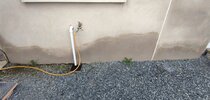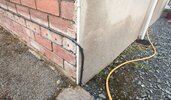Hi Guys,
The property in the photo illustrates a plaster-rendered wall with damp appearing to be rising up it. It was plastered about a year or two ago.
Initially, I thought it was possibly just the plaster drying out but quite recently it has now started to show some salts in one place, which is concerning.
It is an original brick wall behind the plaster (cavity with a dpc), and on the right-hand side of the vertical silicone line, it has a new extension (cavity wall with blocks and dpc) and it is even rising up the new wall as well., although not quite as high.
1. What is the likely cause of this and
2. How should I go about fixing it?
Thanks
The property in the photo illustrates a plaster-rendered wall with damp appearing to be rising up it. It was plastered about a year or two ago.
Initially, I thought it was possibly just the plaster drying out but quite recently it has now started to show some salts in one place, which is concerning.
It is an original brick wall behind the plaster (cavity with a dpc), and on the right-hand side of the vertical silicone line, it has a new extension (cavity wall with blocks and dpc) and it is even rising up the new wall as well., although not quite as high.
1. What is the likely cause of this and
2. How should I go about fixing it?
Thanks



